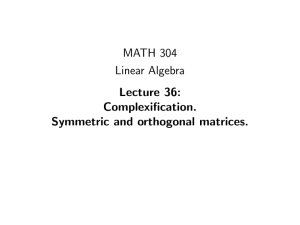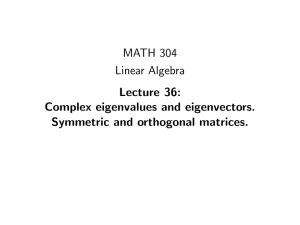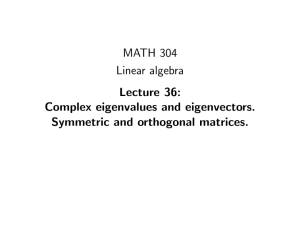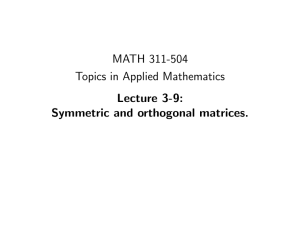Math 304-504 Linear algebra Lecture 35: Symmetric and orthogonal matrices.
advertisement
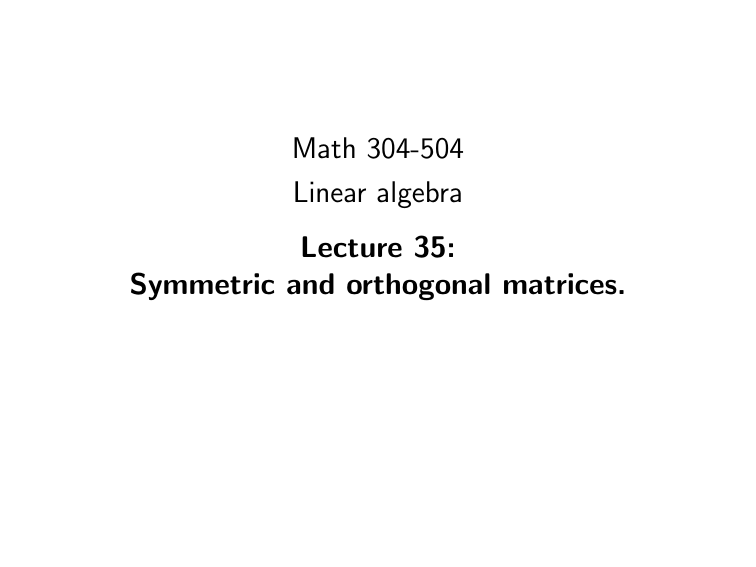
Math 304-504 Linear algebra Lecture 35: Symmetric and orthogonal matrices. 0 −1 Problem. Let A = . Find e tA . 1 0 0 1 1 −1 0 , A3 = , A4 = A2 = 0 −1 −1 0 0 tn n t2 2 a(t) tA e = I +tA+ A + · · · + A + · · · = c(t) 2! n! where a(t) = 1 − 3 t2 2! 5 + t4 4! − · · · = cos t, b(t) = −t + t3! − t5! + · · · = − sin t, c(t) = −b(t) = sin t, d(t) = a(t) = cos t. cos t − sin t tA Thus e = . sin t cos t 0 ,. . . 1 b(t) , d(t) Let Aφ = cos φ − sin φ . sin φ cos φ • A is the matrix of rotation by angle φ • Aφ Aψ = Aφ+ψ • ATφ = A−φ T • A−1 φ = A−φ = Aφ • Columns of Aφ form an orthonormal basis for R2 • Rows of Aφ form an orthonormal basis for R2 Proposition For any n×n matrix A and any vectors x, y ∈ Rn , Ax · y = x · AT y. Proof: Ax · y = yT Ax = (yT Ax)T = xT AT y = = AT y · x = x · AT y. Definition. An n×n matrix A is called • symmetric if AT = A; • orthogonal if AAT = AT A = I , that is, if AT = A−1 ; • normal if AAT = AT A. Clearly, symmetric and orthogonal matrices are normal. Theorem If x and y are eigenvectors of a symmetric matrix A associated with different eigenvalues, then x · y = 0. Proof: Suppose Ax = λx and Ay = µy, where λ 6= µ. Then Ax · y = λ(x · y), x · Ay = µ(x · y). But Ax · y = x · AT y = x · Ay. Thus λ(x · y) = µ(x · y) =⇒ x · y = 0. Theorem Suppose A is a symmetric n×n matrix. Then (a) all eigenvalues of A are real; (b) there exists an orthonormal basis for Rn consisting of eigenvectors of A. 1 0 1 Example. A = 0 3 0. 1 0 1 • A is symmetric. • A has three eigenvalues: 0, 2, and 3. • Associated eigenvectors are v1 = (−1, 0, 1), v2 = (1, 0, 1), and v3 = (0, 1, 0). • Vectors v1 , v2 , v3 form an orthogonal basis for R3 . Theorem If A is a normal matrix then N(A) = N(AT ) (that is, Ax = 0 ⇐⇒ AT x = 0). Proof: Ax = 0 ⇐⇒ Ax · Ax = 0 ⇐⇒ x · AT Ax = 0 ⇐⇒ x · AAT x = 0 ⇐⇒ AT x · AT x = 0 ⇐⇒ AT x = 0. Proposition If a matrix A is normal, so are matrices A − λI , λ ∈ R. Proof: Let B = A − λI , where λ ∈ R. Then B T = (A − λI )T = AT − (λI )T = AT − λI . We have BB T = (A − λI )(AT − λI ) = AAT − λA − λAT + λ2 I , B T B = (AT − λI )(A − λI ) = AT A − λA − λAT + λ2 I . Hence AAT = AT A =⇒ BB T = B T B. Thus any normal matrix A shares with AT all real eigenvalues and the corresponding eigenvectors. How about complex eigenvalues? Dot product of complex vectors Dot product of real vectors x = (x1 , . . . , xn ), y = (y1 , . . . , yn ) ∈ Rn : x · y = x1 y1 + x2 y2 + · · · + xn yn . Dot product of complex vectors x = (x1 , . . . , xn ), y = (y1 , . . . , yn ) ∈ Cn : x · y = x1 y1 + x2 y2 + · · · + xn yn . If z = r + it (r , t ∈ R) then z = r − it, zz = r 2 + t 2 = |z|2 . Hence x · x = |x1 |2 + |x2 |2 + · · · + |xn |2 ≥ 0. Also, x · x = 0 if and only if x = 0. Since z + w = z + w and zw = z w , it follows that y · x = x · y. Definition. Let V be a complex vector space. A function β : V × V → C, denoted β(x, y) = hx, yi, is called an inner product on V if (i) hx, yi ≥ 0, hx, xi = 0 only for x = 0 (positivity) (conjugate symmetry) (ii) hx, yi = hy, xi (iii) hr x, yi = r hx, yi (homogeneity) (iv) hx + y, zi = hx, zi + hy, zi (additivity) hx, yi is complex-linear as a function of x. The dependence on the second argument is called half-linearity : hx, λy + µzi = λhx, yi + µhx, zi. Z b f (x)g (x) dx, Example. hf , g i = a f , g ∈ C ([a, b], C). Theorem Suppose A is a normal matrix. Then for any x ∈ Cn and λ ∈ C one has Ax = λx ⇐⇒ AT x = λx. Corollary All eigenvalues of a symmetric matrix are real. All eigenvalues λ of an orthogonal matrix satisfy |λ| = 1. Theorem Suppose A is a normal n×n matrix. Then there exists an orthonormal basis for Cn consisting of eigenvectors of A. Orthogonal matrices Theorem Given an n×n matrix A, the following conditions are equivalent: (i) A is orthogonal: AT = A−1 ; (ii) columns of A form an orthonormal basis for Rn ; (iii) rows of A form an orthonormal basis for Rn . [Entries of the matrix AT A are the dot products of columns of A. Entries of AAT are the dot products of rows of A.] Thus an orthogonal matrix is the transition matrix from one orthonormal basis to another.

